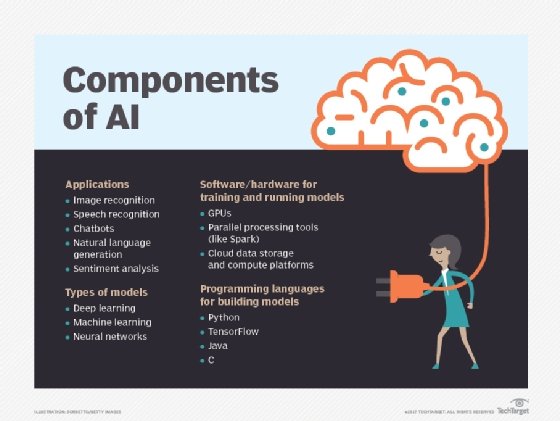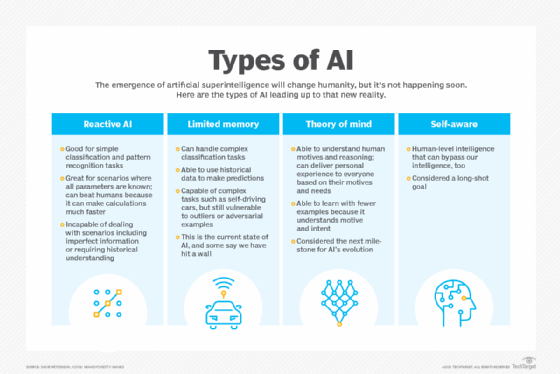


Artificial neural networks and deep learning artificial intelligence technologies are quickly evolving, primarily because AI processes large amounts of data much faster and makes predictions more accurately than humanly possible.
While the huge volume of data being created on a daily basis would bury a human researcher, AI applications that use machine learning can take that data and quickly turn it into actionable information. As of this writing, the primary disadvantage of using AI is that it is expensive to process the large amounts of data that AI programming requires.
AI can be categorized as either weak or strong. Weak AI, also known as narrow AI, is an AI system that is designed and trained to complete a specific task. Industrial robots and virtual personal assistants, such as Apple's Siri, use weak AI.
Strong AI, also known as artificial general intelligence (AGI), describes programming that can replicate the cognitive abilities of the human brain. When presented with an unfamiliar task, a strong AI system can use fuzzy logic to apply knowledge from one domain to another and find a solution autonomously. In theory, a strong AI program should be able to pass both a Turing test and the Chinese room test.
Some industry experts believe the term artificial intelligence is too closely linked to popular culture, and this has caused the general public to have improbable expectations about how AI will change the workplace and life in general. Some researchers and marketers hope the label augmented intelligence, which has a more neutral connotation, will help people understand that most implementations of AI will be weak and simply improve products and services.
The concept of the technological singularity -- a future ruled by an artificial superintelligence that far surpasses the human brain's ability to understand it or how it is shaping our reality -- remains within the realm of science fiction.
While AI tools present a range of new functionality for businesses, the use of artificial intelligence also raises ethical questions because, for better or worse, an AI system will reinforce what it has already learned.
This can be problematic because machine learning algorithms, which underpin many of the most advanced AI tools, are only as smart as the data they are given in training. Because a human being selects what data is used to train an AI program, the potential for machine learning bias is inherent and must be monitored closely.
Anyone looking to use machine learning as part of real-world, in-production systems needs to factor ethics into their AI training processes and strive to avoid bias. This is especially true when using AI algorithms that are inherently unexplainable in deep learning and generative adversarial network (GAN) applications.
Explainability is a potential stumbling block to using AI in industries that operate under strict regulatory compliance requirements. For example, financial institutions in the United States operate under regulations that require them to explain their credit-issuing decisions. When a decision to refuse credit is made by AI programming, however, it can be difficult to explain how the decision was arrived at because the AI tools used to make such decisions operate by teasing out subtle correlations between thousands of variables. When the decision-making process cannot be explained, the program may be referred to as black box AI.
Some industry experts believe the term artificial intelligence is too closely linked to popular culture, and this has caused the general public to have improbable expectations about how AI will change the workplace and life in general. Some researchers and marketers hope the label augmented intelligence, which has a more neutral connotation, will help people understand that most implementations of AI will be weak and simply improve products and services.
The concept of the technological singularity -- a future ruled by an artificial superintelligence that far surpasses the human brain's ability to understand it or how it is shaping our reality -- remains within the realm of science fiction.
While AI tools present a range of new functionality for businesses, the use of artificial intelligence also raises ethical questions because, for better or worse, an AI system will reinforce what it has already learned.
This can be problematic because machine learning algorithms, which underpin many of the most advanced AI tools, are only as smart as the data they are given in training. Because a human being selects what data is used to train an AI program, the potential for machine learning bias is inherent and must be monitored closely.
Anyone looking to use machine learning as part of real-world, in-production systems needs to factor ethics into their AI training processes and strive to avoid bias. This is especially true when using AI algorithms that are inherently unexplainable in deep learning and generative adversarial network (GAN) applications.
Explainability is a potential stumbling block to using AI in industries that operate under strict regulatory compliance requirements. For example, financial institutions in the United States operate under regulations that require them to explain their credit-issuing decisions. When a decision to refuse credit is made by AI programming, however, it can be difficult to explain how the decision was arrived at because the AI tools used to make such decisions operate by teasing out subtle correlations between thousands of variables. When the decision-making process cannot be explained, the program may be referred to as black box AI.
As the hype around AI has accelerated, vendors have been scrambling to promote how their products and services use AI. Often what they refer to as AI is simply one component of AI, such as machine learning. AI requires a foundation of specialized hardware and software for writing and training machine learning algorithms. No one programming language is synonymous with AI, but a few, including Python, R and Java, are popular.

Because hardware, software and staffing costs for AI can be expensive, many vendors are including AI components in their standard offerings or providing access to artificial intelligence as a service (AIaaS) platforms. AIaaS allows individuals and companies to experiment with AI for various business purposes and sample multiple platforms before making a commitment.
Popular AI cloud offerings include the following:
Arend Hintze, an assistant professor of integrative biology and computer science and engineering at Michigan State University, explained in a 2016 article that AI can be categorized into four types, beginning with the task-specific intelligent systems in wide use today and progressing to sentient systems, which do not yet exist. The categories are as follows:
The terms AI and cognitive computing are sometimes used interchangeably, but, generally speaking, the label AI is used in reference to machines that replace human intelligence by simulating how we sense, learn, process and react to information in the environment.
The label cognitive computing is used in reference to products and services that mimic and augment human thought processes
Arend Hintze, an assistant professor of integrative biology and computer science and engineering at Michigan State University, explained in a 2016 article that AI can be categorized into four types, beginning with the task-specific intelligent systems in wide use today and progressing to sentient systems, which do not yet exist. The categories are as follows:

AI is incorporated into a variety of different types of technology. Here are six examples: